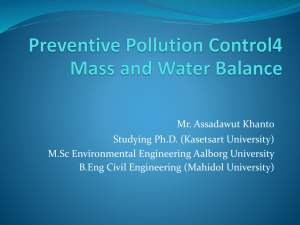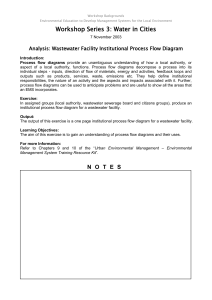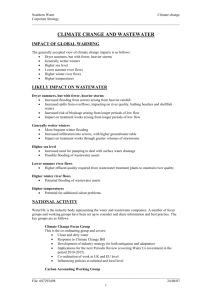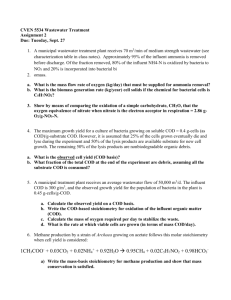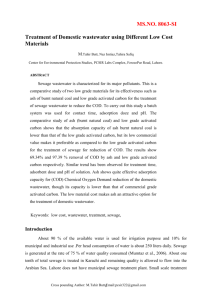Design and Performance of a Horizontal Flow Constructed Wetland
advertisement
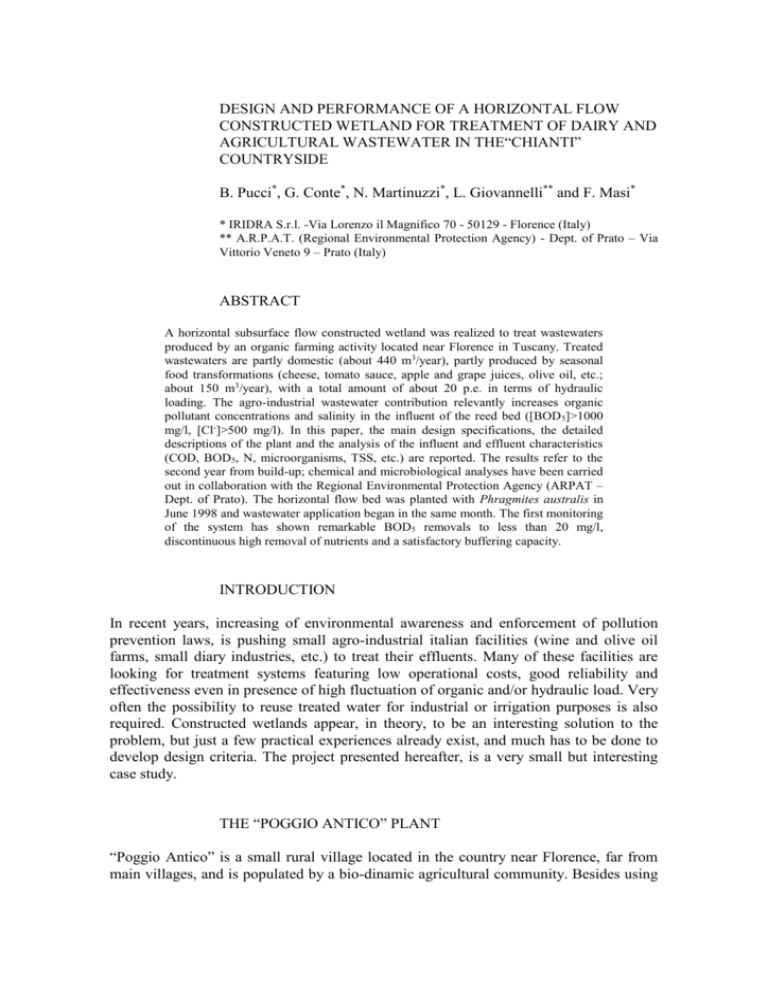
DESIGN AND PERFORMANCE OF A HORIZONTAL FLOW CONSTRUCTED WETLAND FOR TREATMENT OF DAIRY AND AGRICULTURAL WASTEWATER IN THE“CHIANTI” COUNTRYSIDE B. Pucci*, G. Conte*, N. Martinuzzi*, L. Giovannelli** and F. Masi* * IRIDRA S.r.l. -Via Lorenzo il Magnifico 70 - 50129 - Florence (Italy) ** A.R.P.A.T. (Regional Environmental Protection Agency) - Dept. of Prato – Via Vittorio Veneto 9 – Prato (Italy) ABSTRACT A horizontal subsurface flow constructed wetland was realized to treat wastewaters produced by an organic farming activity located near Florence in Tuscany. Treated wastewaters are partly domestic (about 440 m3/year), partly produced by seasonal food transformations (cheese, tomato sauce, apple and grape juices, olive oil, etc.; about 150 m3/year), with a total amount of about 20 p.e. in terms of hydraulic loading. The agro-industrial wastewater contribution relevantly increases organic pollutant concentrations and salinity in the influent of the reed bed ([BOD 5]>1000 mg/l, [Cl-]>500 mg/l). In this paper, the main design specifications, the detailed descriptions of the plant and the analysis of the influent and effluent characteristics (COD, BOD5, N, microorganisms, TSS, etc.) are reported. The results refer to the second year from build-up; chemical and microbiological analyses have been carried out in collaboration with the Regional Environmental Protection Agency (ARPAT – Dept. of Prato). The horizontal flow bed was planted with Phragmites australis in June 1998 and wastewater application began in the same month. The first monitoring of the system has shown remarkable BOD5 removals to less than 20 mg/l, discontinuous high removal of nutrients and a satisfactory buffering capacity. INTRODUCTION In recent years, increasing of environmental awareness and enforcement of pollution prevention laws, is pushing small agro-industrial italian facilities (wine and olive oil farms, small diary industries, etc.) to treat their effluents. Many of these facilities are looking for treatment systems featuring low operational costs, good reliability and effectiveness even in presence of high fluctuation of organic and/or hydraulic load. Very often the possibility to reuse treated water for industrial or irrigation purposes is also required. Constructed wetlands appear, in theory, to be an interesting solution to the problem, but just a few practical experiences already exist, and much has to be done to develop design criteria. The project presented hereafter, is a very small but interesting case study. THE “POGGIO ANTICO” PLANT “Poggio Antico” is a small rural village located in the country near Florence, far from main villages, and is populated by a bio-dinamic agricultural community. Besides using organic farming, wind and solar energy the community was also interested in water reuse for irrigation and wastewater natural treatment. Being their activities yearly related to products availability, wastewater produced by the different food transformation processes undergoes significant quality changes. Dealing with a mix of domestic and industrial wastewater, the first problem to be addressed was to estimate the maximum load: in fact, the baseline domestic hydraulic and organic load (440 m3/year) was increased either regularly (diary industry) or seasonally (tomato sauce, apple and grape juices, olive oil) by the agroindustrial load (about 150 m3/year). In order to define the maximum load and set up design criteria for sizing the system, both wastewater flow and concentration of pollutants in different period of the year have been monitored. The baseline data used for sizing the plants are reported in the Table 1. Table 1 - Dimensioning parameters Population equivalent Estimated water consumption rate * p.e. Average daily flow Q COD inlet Imhoff tank COD inlet SFS-h 20 p.e. 120 l/p.e.*d 1.6 m3/d 1200 mg/ l 1000 mg/ l The system chosen to treat the Imhoff effluent is an horizontal subsurface flow constructed wetland. The CW system consists of a single bed (Table 2). The bed (15.5x4.5x0.7 m) utilises an impermeable polyethylene membrane separated from the ground by a single layer of geotextile. The macrophyte species chosen for the process was Phragmites australis (reed grass), which is an autochthonous species already present in the area. The plant density was 4 rhizomes/m2 and the bed was totally covered by the vegetation already in the late summer after the start-up in June ’98. The principal design specifications and the detailed descriptions of the system are summarized in Table 2. Table 2 - SFS-h design parameters Bottom slope Average depth Substrate 1% 0.7 D 10 Porosity (n) Substrate size in feeding and drainage zones Total Area of the SFS-h bed Average cross section area Total available Volume HRT 8 mm 0.35 6-8 cm 70 m2 3.5 m2 19.6 m3 6.5 d RESULTS AND DISCUSSION The treatment facility has shown a considerable tolerance to influent concentrations. This is well explained by the long , about 6 days, HRT, which creates a high buffering capacity to cope with a highly variable nature of the incoming wastewater, in agreement with findings of Kadlec and Knight (1996). The influent wastewater, with a 1100 mg/l mean COD concentration, falls under the class of strong sewage (Metcalf et al, 1991). Only three samples, with monthly frequency, were analyzed by ARPAT labs according to methods described in Standard Methods (APHA, 1993). In Table 3 all figures obtained from carried out analyses are reported in detail, while the Figures 1 and 2 below indicate mean overall removal rates for main pollutants. Table 3 – Results obtained from three samples in the last year with specific removal rates Parameter Temp TSS COD 12/99 In 13 105 1136 12/99 Out 14 20 38 71.9 0.05 99.93 1.3 0.17 86.72 25.4 44.1 -73.62 Mg/L N Mg/L N Mg/L N 0.02 0.05 75.3 0.05 0.01 53.2 -150.00 80.00 29.35 0.49 50.6 0.27 55.3 44.9 -9.29 0.31 38.1 0.23 55 25.81 -44.36 Mg/L P 6.35 2.27 64.25 44.2 33.7 23.76 2.4 6.31 -162.92 mg/L mg/L Ufc/100ml Ufc/100ml Ufc/100ml Ufc/100ml 8 1.8 1.E+06 5.E+05 3.E+06 3.E+05 1.12 0.42 2.E+04 1.E+03 5.E+03 1.E+03 86.00 76.67 98.50 99.80 99.83 99.67 5.49 3.42 1.E+06 2.E+05 8.E+05 1.E+05 1.2 1.34 3500 600 3000 100 78.14 60.82 99.65 99.67 99.63 99.90 4.9 1.12 6.E+05 2.E+05 3.E+06 1.E+05 1.44 0.27 5000 800 3000 500 70.61 75.89 99.17 99.47 99.91 99.50 °C mg/L Mg/L O2 Ammonium Mg/L NH4 Nitrites Nitrates Total Nitrogen Total Phosphorus MBAS BiAS Total Coli. Faec. Coli. Faec. Strept. Esch. Coli. rem% 80.95 96.65 04/00 04/00 05/00 05/00 In Out Rem% In Out 14 15 18 19 316 58 81.65 13.9 4.9 1760 95 94.6 418 87 rem % 64.75 79.19 1200 1000 mg/l 800 IN OUT 600 400 200 0 TSS COD Fig. 1- Mean concentrations of TSS and COD in the inlet and outlet of the reed bed The observed removal efficiencies are high for COD (93%), TSS (81%), tensides (MBAS 80%; BiAS 68%) and hygienic parameters (TC 99.1%; FC 99.7%; FS 99.8%; Esch.C 99.7%), relatively low for Ammonium (55%), Nitrates (40%) and Total Phosphorus (20%), very low for Total Nitrogen (0.3%). The last figure can be explained by the alternate discharge of wastewater from the little dairy facility (twice per week) together with the monitoring strategy: inlet and outlet samples are, in fact, collected in the same time and therefore, given the few available data, it is impossible to correlate with sufficient accuracy the inlet and outlet concentrations. As a matter of fact, for the time being good nitrification and denitrification are not present in the system. However, it must be pointed out that the latter parameters are not taken into account by the new national law (DL 152/99 in receipment of EU Directive 271/91) applied to this specific case (less than 2000 PE with discharge in a superficial water body not classified as “sensible”). 60 50 mg/l 40 IN OUT 30 20 10 0 NH4-N NO3-N Ntot Ptot MBAS BiAS Fig. 2 - Mean concentrations of Ammonium, Nitrates, Total Nitrogen, Total Phosphorus, MBAS and BiAS in the inlet and outlet of the reed bed REFERENCES APHA (1993). Standard methods for Examination of Water and Wastewater. 18th ed., APHA/AWWA/WEF, Washington DC, USA. Kadlec R. H., Knight R. L. (1996). Treatment Wetlands. CRC Press/Lewis Publishers, Boca Raton, Florida, pp. 39-46. Metcalf L., Eddy H.P., Tchobanoglous G. (1991). Wastewater engineering: treatment, disposal and reuse. 3rd ed. McGraw Hill. Steiner G.R., Watson J.T. and Choate K.D. (1993). General design, construction, and operation guidelines for small constructed wetlands wastewater treatment systems. In: Constructed Wetlands for Water Quality Improvement. G. A. Moshiri Ed., Lewis, Boca Raton, pp. 203-217. U.S.E.P.A. (1993). Subsurface flow constructed wetlands for wastewater treatment. EPA 832-R-93-001, U.S.E.P.A. Office of Water (WH547).




